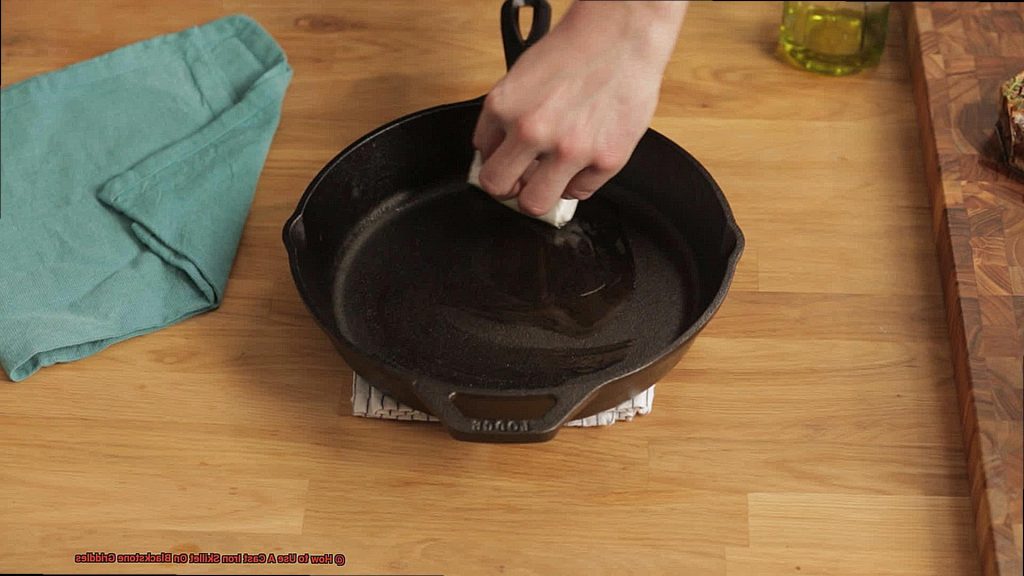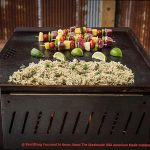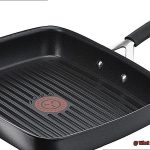Are you getting the most out of your Blackstone Griddle? A cast iron skillet is an easy way to bring flavor and versatility to your griddle cooking. Whether you’re a master chef or just starting out, using a cast iron skillet on your Blackstone Griddle will take your cooking to the next level.
On a Blackstone Griddle, a cast iron skillet offers endless possibilities. Make delicious breakfast dishes like omelets, pancakes, and French toast with it. Or try savory options like grilled cheese sandwiches, quesadillas, or even steak. The possibilities are endless.
Cooking with a cast iron skillet on a Blackstone Griddle is simple. Just heat your griddle to medium-high heat, add some oil or butter, and preheat the skillet before adding any food so that it cooks evenly and doesn’t stick.
Then, get ready for the best griddle cooking has to offer. You’ll enjoy the distinct flavor that comes from cooking with cast iron and be able to make delicious meals quickly and efficiently. So what are you waiting for?
Get your cast iron skillet today and start experiencing all that griddle cooking has to offer.
Contents
Preheat the Griddle
Using a Blackstone griddle with a cast iron skillet is an excellent way to create delicious meals. However, before you get started, there’s one essential step that you must take: preheat the griddle.
The preheating process ensures that the food is cooked evenly and to perfection, so it’s important to do it correctly.
To preheat the griddle, turn it on to high heat for at least 10 minutes and keep the lid on. This will help trap heat and make sure that the griddle heats up quickly.
Additionally, adding some oil to the griddle before preheating will help create a non-stick surface and prevent food from sticking.
The temperature of the griddle should also be adjusted depending on what type of food is being cooked. For instance, if cooking meat, it is recommended to preheat the griddle at a higher temperature than if cooking vegetables.
This will help sear the meat and ensure that it stays moist and tender.
Adding Oil to the Cast Iron Skillet
Using a cast iron skillet on a Blackstone griddle is made even better with the addition of oil. This helps to create a protective layer on the surface of the skillet, preventing food from sticking, and helps to evenly distribute heat. However, it’s essential to use the right kind of oil and preheat the skillet before cooking.
The best oils for seasoning your cast iron skillet are those with a high smoke point such as vegetable oil, coconut oil, or grapeseed oil. Pour a small amount of oil onto the skillet’s surface and use a paper towel to spread it evenly; be sure not to use too much as this can make your food greasy and alter its flavor.
Before adding any food, preheat the skillet on the Blackstone griddle for around 5 minutes. This ensures that the skillet is evenly heated and that the oil is distributed properly across its surface, preventing food from sticking.
When you are finished cooking, avoid washing your cast iron skillet with soap and water.

Instead, use a scraping tool to remove any residue and rinse with warm water. Dry off with a towel then add another thin layer of oil before storing in a dry place.
Cooking with a Cast Iron Skillet on a Blackstone Griddle
Cooking with a cast iron skillet on a Blackstone griddle is an easy and efficient way to make delicious meals. With its large, flat surface area, the Blackstone griddle allows for multiple dishes to be cooked at once and the cast iron skillet retains heat well, distributing it evenly throughout the food.
Before you get started, it’s important to season your cast iron skillet. This helps to build up a non-stick surface on the skillet so that food doesn’t stick while cooking. To do this, apply a coat of oil to the skillet and heat it on the griddle until it begins to smoke.
Then, remove the skillet from the griddle and let it cool before applying another coat of oil and repeating the process.
Once your skillet is seasoned and ready to go, preheat it on the griddle for about 10 minutes before adding any food. You can test if the skillet is hot enough by sprinkling a few drops of water on it – if the water sizzles and evaporates immediately, you’re good to go.
With your cast iron skillet, you can use a variety of cooking methods such as searing, pan-frying, sautéing or even baking; just make sure you use heat-resistant utensils like wooden or silicone utensils when cooking with cast iron.
Avoid Direct Contact of the Skillet with the Griddle Surface
Cooking with a cast iron skillet on a Blackstone griddle is an excellent way to explore your culinary creativity and enjoy delicious meals. But to keep both the skillet and griddle in top condition, it’s important to take steps to avoid direct contact between them.
The simplest way to do this is by laying parchment paper or aluminum foil between the skillet and griddle surface. This will protect both surfaces from scratches, as well as making any spills easier to clean up. You can also use a wire rack or trivet for extra elevation, which will promote even cooking and prevent food from sticking to the skillet.
It’s also essential that you season your cast iron skillet before use. This will not only help it stay rust-free and prevent sticking, but it’s like giving your beloved kitchen tool a warm hug. With proper seasoning, your cast iron skillet can provide years of reliable service.
Avoid Using Acidic Ingredients on a Cast Iron Skillet
Cooking with a cast iron skillet is an art, and taking care of it is essential for optimal performance. One important aspect to keep in mind is avoiding acidic ingredients on the skillet.
Vinegar, tomatoes, citrus juices, and wine can all react with the cast iron, resulting in discoloration, rusting, and damage to the surface. To prevent this from happening, it’s best to use stainless steel or enamel-coated pans for dishes that include these ingredients.
If you must use a cast iron skillet for a recipe that requires acidic ingredients, make sure you oil the skillet well before use and avoid leaving the food in the skillet for too long. Acids have a tendency to break down the seasoning on the cast iron surface over time, and leaving food in it will only increase its chances of causing damage.
Don’t forget to clean off any acidic residue left on the skillet immediately after use. Use a soft sponge or brush with warm water – avoid using soap or detergent as it can also harm the seasoning on your skillet.
The Benefits of Using a Cast Iron Skillet on a Blackstone Griddle
Cooking on a Blackstone griddle is an art form, and a cast iron skillet is the perfect tool to help you master it. Not only is it durable and versatile, but it also offers some unique benefits that make it the ideal cooking companion for your Blackstone griddle.
The even heat distribution of a cast iron skillet ensures that your food is cooked evenly and thoroughly when placed on a Blackstone griddle.
It also holds heat longer than other styles of cookware, making it ideal for searing steaks, burgers, or other meats. Moreover, the skillet’s intense heat helps caramelize your food, resulting in a crispy golden crust packed with flavor.
Cleaning up after cooking with a cast iron skillet is also easy. Simply rinse the skillet with warm water and dry it thoroughly; no need for harsh chemicals or scrubbing is required.
And because the cast iron skillet is seasoned, it will also help prevent food from sticking to the griddle – making clean-up even simpler.
Using a cast iron skillet on a Blackstone griddle will take your culinary skills to new heights.
Tips for Maintaining Your Cast Iron Skillet
Cast iron skillets have been a staple in many kitchens for centuries, providing delicious meals and long-term care. To ensure that your cast iron skillet stays in top condition, here are some essential tips on how to maintain it.
- Firstly, always dry your skillet after washing it. This can be done on the stovetop or in the oven, depending on the recipe. To keep it seasoned, rub a tiny amount of vegetable oil into the skillet once it’s dry.
- Secondly, avoid using soap or harsh detergents when washing your cast iron skillet. Rather, use warm water and a brush or sponge to clean it and then wipe it dry with a cloth or paper towel immediately after. Abrasive scouring pads should also be avoided as they can scratch and damage the seasoning of your skillet.
- It’s also essential to store your cast iron skillet correctly. Never stack your cast iron skillet on top of other kitchenware as this can cause scratches or chips. Instead, store it in a dry place, and if possible, hang it up using a hook.
- Finally, invest in a cast iron skillet cover or wrap it in a paper towel to prevent rust and keep the skillet in excellent condition when not in use.
Conclusion
Using a cast iron skillet on your Blackstone Griddle is an excellent way to take your griddle cooking skills to the next level. With its unique flavor and versatility, you can create delicious meals with ease. However, there are certain steps you should take to ensure optimal results.
Start by preheating your griddle before use and adding oil to the skillet for a non-stick surface.
Adjust the temperature of the griddle according to the type of food you’re making; high heat is best for searing meat, while lower temperatures are more suitable for vegetables.
Additionally, it’s important to season your cast iron skillet before use and avoid using acidic ingredients such as vinegar or tomatoes.
After use, be sure to avoid using soap or detergent when washing it and store it in a dry place for maximum longevity.






